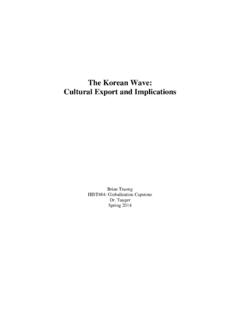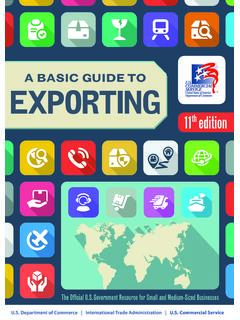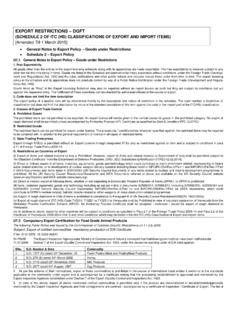Transcription of Export Potential Assessments
1 1 Export Potential Assessments A methodolog y to i de ntify Export opportunities for develop ing countries Yvan Decreux and Jul ia Spie s1 with contributions fr om Dzmitry Kniahin, Jie Shen g and Maria Del Mar Cantero Draft version as of December 2016 Abstract In order to assist developing countries in identifying promising products for inclusion into Export promotion activities, the International Trade Centre (ITC) has developed an Export Potential assessment methodology. It is based on a decomposition of a country s Potential exports of a product to a given target market into three factors: supply, demand and easiness to trade. Depending on the country s particular needs, two approaches are available. (i) The Export Potential Indicator (EPI) serves countries that aim to support established Export sectors in increasing their exports to existing and new markets. Inspired by a gravity-type framework, the EPI identifies products in which the exporting country has already proven to be internationally competitive and which have good prospects of Export success in a given target market.
2 (ii) The Product Diversification Indicator (PDI) serves countries that aim to diversify and develop new Export sectors. Based on Hausmann and Hidalgo's notion of the product space, the PDI identifies products which the exporting country does not yet competitively Export but which seem feasible given the country's current Export basket and the Export baskets of similar countries. Additional indicators that reflect policy objectives allow refining the selection of promising products. Results prove to be stable over time, turning them into a suitable information base for a country s medium-term Export strategies or development programmes. 1 The authors are highly indebted to the below listed colleagues for their valuable contributions. Lionel Fontagn has thoroughly reviewed the paper and provided comments that helped improving it considerably. Thanks go also to participants of seminars at ITC and WTO during which the methodology was presented and discussed.
3 2 Introduction Purpose Trade and economic well-being rely on the availability and the sound governance of resources. Horizontal policies aiming at improving the efficiency of border procedures, harmonizing regulations on products and services, and increasing transparency of these rules are ways to create an environment that is conducive to an optimal use of resources. Nevertheless, governments do not limit themselves to horizontal policies but set up specialized agencies, seek developmental aid and negotiate trade rules that are by no means sector-neutral. Against this reality, Hausmann and Rodrik (2006) state that interventions that increase the size and profitability of certain activities are legitimate if they contribute to the rest of society through taxes and higher productivity jobs and conclude we may be doomed to choose, but we should only choose when the maximum amount of information has been revealed. In order to bring transparency into the selection of products, sectors and markets for Export promotion activities, the International Trade Centre (ITC) has developed an Export Potential assessment methodology.
4 Based on detailed trade and market access information, it allows identifying depending on the needs of the country existing products with high Export Potential and/or diversification opportunities in a given target market: The Export Potential Indicator (EPI) serves countries that aim to support established Export sectors in increasing their exports to new or existing target markets. It identifies products in which the exporting country has already proven to be internationally competitive and which have good prospects of Export success in specific target market(s) (intensive product margin). The Product Diversification Indicator (PDI) serves countries that aim to diversify and develop new Export sectors that face promising demand conditions in new or existing target markets. It identifies products which the exporting country does not yet Export competitively but which seem feasible based on the country s current Export basket and the Export baskets of similar countries (extensive product margin).
5 Conceptually, Export Potential Assessments are based on the assumption that in a world without frictions trade flows can be described as a combination of supply performance, easiness to Export and total demand. While a country s capacity to supply existing products (EPI) is captured through projected market shares, its capacity to diversify into new products (PDI) relies on Hausmann and Hidalgo s concept of the product space (Hausmann and Klinger, 2007, Hausmann et al., 2007 and Hidalgo et al., 2007) that establishes links between products through an assessment of how frequently they are found together in the Export baskets of countries. The first approach the EPI is based on a structural model that (i) identifies Potential Export values from supply capacities in the exporting country, demand conditions in the target market and bilateral linkages between the two. This corresponds to an empirical specification with exporter product, importer product and exporter importer fixed effects but avoids computational constraints when working at a detailed product Any gap between what countries could Export and what they actually do Export is then argued to result from factors that trade advisors may address together with local companies, such as for example lacking information about the rules and regulations of the target market or difficulties in complying with them or in meeting the (quality) preferences of its consumers.
6 The second approach the PDI is based on the concept of the product space. The Export Potential assessment methodology improves the purely outcome-based measure of linkages to new products by accounting for natural endowments that are pivotal for the capacity of a country to produce certain 2 See Head and Mayer (2014). 3 products. It also responds to recent criticisms of the product space of being entirely supply-side driven (see Harrison and Rodriguez-Clare, 2011 or Lederman and Maloney, 2012) by combining it with demand and market access information. Since the descriptive nature of the product space does not allow for any meaningful estimate of Potential trade values, we present rankings of diversification opportunities in a given country or regional market. Very few attempts to give data-based guidance to developing countries on Export opportunities have been made. One of them is the Decision Support Model (DSM) that starts by analysing the macroeconomic conditions of a large number of Potential target markets and then, using a filtering approach, systematically screens possible product-market combinations (according to criteria such as import growth, size, market concentration and accessibility) until a shortlist of the most promising, realistic opportunities remains (Cuyvers et al.)
7 , 2012). The DSM differs from Export Potential Assessments in that it relies on filters. Starting with all possible product-country combinations, it differentiates only at the end between products that fall within a country s demonstrated Export (supply) capacity and those that fall outside of it. In this way, new Potential product-target market combinations are the residual of the filtering process and not derived from a dedicated approach to capture the extensive margin of trade. With the recent advances of the product space, a number of institutions (including UNCTAD and the World Bank) have started advising on diversification opportunities based on supply-side linkages between products. As mentioned above, these approaches disregard demand and market access factors that impact a country s Export decisions. This paper starts with describing the methodology to measure the Export and diversification Potential of products in given target markets.
8 It continues explaining in detail how data was processed and treated in order to achieve robust and reliable results for all countries in the world. For each product deemed feasible , indicators assessing its desirability from a social and developmental perspective are introduced. Finally, an exemplary output for one country, Iraq, is discussed along with checks of robustness based on all countries results. Limitations Export Potential Assessments are a quantitative approach to identify promising Export sectors and markets on a global scale, largely based on trade and market access data. While the EPI is derived from a structural decomposition of trade into supply, demand and bilateral linkages and provides with an estimate of Potential Export values, the PDI is based on the descriptive, outcome-based concept of the product space. Export Potential Assessments therefore refrain from reporting any Potential dollar value that could be associated with the identified diversification opportunities and provide only within-market ranks of products.
9 In addition to the measurable components of Export Potential , there are other, often intangible, factors to consider when selecting sectors and products to target through trade development programmes. These include for example, the willingness and possibility to attract foreign direct investment, the possibilities of marketing and branding and the existence of synergic development plans or sector strategies. Export Potential Assessments also abstract from the costs related to Export promotion activities. All of these factors may however influence the feasibility of exporting (more of) certain products. Trade advisors should therefore look at results with a critical eye and engage in further investigations notably with regards to the suggested options for diversification. A few measurable indicators shed additional light upon the desirability of the identified products ( does the product allow stabilizing Export revenues? Does it support the participation of women?)
10 , but most developmental, environmental or social aspects cannot be captured with quantitative trade data. Often, they depend more on production practices than on the choice of products. 4 In light of these limitations, Export Potential Assessments should be seen as a starting point in an Export promotion decision-making process that needs to be followed up with further desk research and consultations with public and private sector stakeholders in the country. Related literature Export Potential Assessments are linked to two different strands of trade literature. The EPI is based on the idea that trade between two countries is positively associated with the level of product supply and demand and negatively associated with trade impediments in the form of customs duties or geographic distance and naturally relates to gravity models. Early attempts to use the gravity model for predicting bilateral trade (especially in the context of East-West integration, see Wang and Winters, 1991; Baldwin, 1994 or Gros and Gonciarz, 1996) have been subject to fundamental critique.







